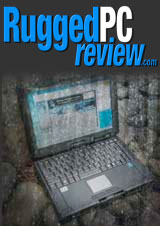|
|
|
|
Dell Latitude 7220 Rugged Extreme Tablet
A year with Dell's powerful and very rugged 12-inch tablet
(by Conrad H. Blickenstorfer)
When it comes to global PC sales and market share, there are the Big Three — Lenovo, HP, and Dell — and then, well behind, there is everyone else. While selling PCs by the tens of millions each year doesn't necessarily guarantee excellence, it certainly means experience, support, and access to the latest technology. If that matters, and to most it does, chances are the Big Three are at least considered for almost every purchase decision. Except when it comes to rugged laptops and tablets. Then there's really only one, and that is Dell. Dell's been making rugged laptops for many years. What's less well known is that Dell also makes rugged tablets.
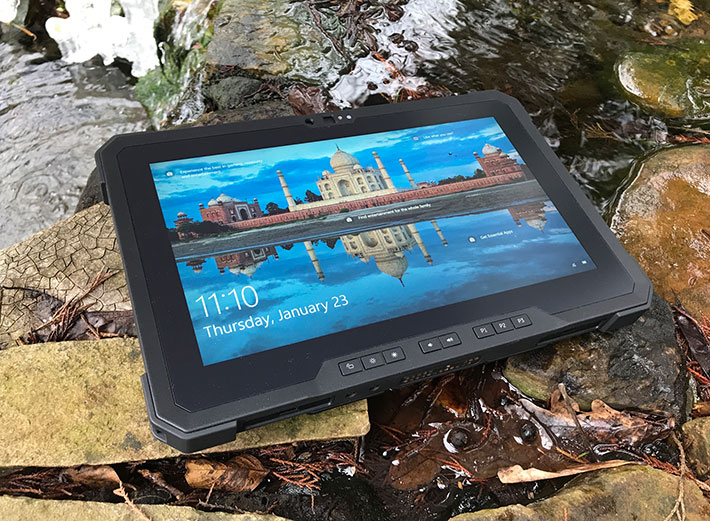
Why does Dell, known for its laptop and desktop computers, have rugged tablets in its lineup? That's because Dell wants to broaden its presence in the rugged mobile computing market where the company has had highly competitive laptops for many years, but only relatively recently entered the faster growing rugged tablet and detachable 2-in-1 market.
Why do I mention the detachable and 2-in-1 aspect of Dell's tablets right upfront? Because Dell has one of the best — and best integrated — keyboards available for any tablet. It's a US$349 option, but it's so good that we consider it pretty much mandatory. This is not one of those awful cardboard-thin keyboard covers that are all but unusable. This one works.
It is a full-scale, fully functional, heavy-duty keyboard with 4-level key backlighting that magnetically snaps onto the tablet with authority. The accompanying kickstand, likewise, is brilliant. It's small and light and never gets in the way, but it makes for a stable 2-in-1 combo that is not in danger of toppling over like many other detachable keyboard solutions. The picture sequence below shows Dell's rugged tablet concept with its optional keyboard and kickstand. The pictures show the original tablet in this line; the latest models work the same.
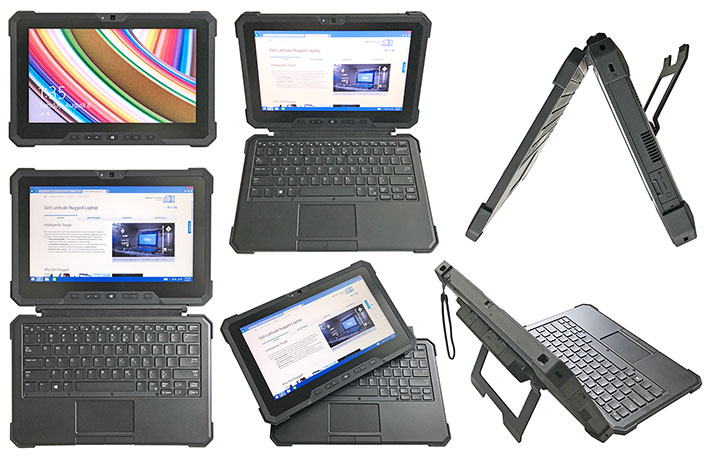
For a brief overview of the Dell Latitude 7220 Rugged Extreme Tablet itself: It has a satisfyingly large 11.6-inch display with capacitive multi-touch. Its 12.3 x 8.0 inch footprint a bit larger than that of the latest Apple iPad Pro 12.9-inch . As a rugged Windows machine with plenty of standard ports, the Dell is, of course, considerably thicker and heavier than the iPad. About an inch thick, and starting at 2.8 pounds. The Dell tablet is powered by a choice of ultra-low voltage Intel 8th generation dual and quad core Core processors. Pricing starts at US$1,899 (as of mid 2020), but nicely equipped one like our review sample, we're talking a good grand more. So this is a fairly high-end product.
Latitude 7220 Rugged Extreme Tablet — latest and greatest rugged Dell tablet
While the rugged Dell Latitude tablet is a relative newcomer to Dell's heavy-duty mobile computer lineup, it's actually been around for five years now. Initially just called the Dell Latitude 12 Rugged Tablet, the second gen that arrived in 2017 added "Extreme" to its name. And somewhere along the line, Dell dropped the "12" that referred to the tablet's 11.6-inch screen and replaced it with "7220," signifying that it's part of the overall Dell Latitude 7000 Series.
The table below shows the major differences between Dell's original rugged tablet, the 2nd generation "extreme" version, and the current 7220 model:
|
Model
|
Rugged Tablet
|
Rugged Tablet 7212
|
Rugged Tablet 7220
|
|
Launched
|
June 2015
|
August 2017
|
October 2019
|
|
CPUs
|
5th gen Intel Core-M
|
6th, 7th, and 8th gen Intel Core
|
8th gen Intel Core
|
|
Display
|
HD 1366 x 768 pixel
|
FHD 1920 x 1080 pixel
|
FHD 1920 x 1080 pixel
|
|
Weight
|
from 3.6 lbs.
|
from 2.8 lbs.
|
from 2.9 lbs.
|
|
RAM
|
up to 8GB
|
up to 16GB
|
up to 16GB
|
|
mSATA Mass storage
|
up to 500GB
|
up to 1TB SATA
|
NA
|
|
PCIe NVMe Mass storage
|
NA
|
up to 1TB
|
up to 2TB PCIe
|
|
Power
|
2 x 26Wh
|
2 x 26Wh or 2 x 34Wh
|
2 x 34Wh
|
|
Battery Life
|
Up to 12 hours
|
Up to 19 hours
|
Unknown
|
|
USB
|
USB 3.0
|
USB 3.0 + USB 3.1 Type-C
|
USB 3.0 + USB 3.1 Type-C
|
|
Handle
|
Soft
|
Soft or hard
|
Soft or hard
|
|
Kickstand
|
fixed angle
|
variable angle (180°)
|
variable angle (180°)
|
First, there's performance. The original tablet came with 4.5-watt Intel 5th generation Core-M processors. Those turned out to be a bit underpowered, and so Dell switched to more powerful Intel 6th, 7th and 8th generation 15-watt full Core processors with their second tablet generation. Dell continued to offer 6th gen processors because those were the last to still support Windows 7, and 7th gen processors because at the time of the 2nd gen's introduction, Intel's 8th gen was still brand-new. Today, the Latitude 7220 Rugged Extreme Tablet is all 8th gen Intel Core processor.
The amount and type of RAM and mass storage can be a large performance difference. Dell was among the earliest to offer the much faster NVMe PCIe-based solid state disks as an option, and NVMe is now standard with the 7220. RAM remains limited to 16GB. We'd like to see 32GB.
Weight always matters in tablets. Dell made the original rugged tablet very solid and that meant even a stripped version weighed in at 3.5 pounds or so. Despite the graduation from mere "Rugged" to "Rugged Extreme," the 2nd gen started at just 2.8 pounds, a noticeable difference. And the latest 7220 is in that neighborhood as well.
The original Dell tablet came with 1366 x 768 pixel resolution, which back then was the norm in this class tablet. The second gen went up to full HD 1920 x 1080 pixel and that's where the 7220 still is as well. Given all those super-sharp smartphones and consumer tablets, we're kind of surprised that premium Windows tablets haven't gone up in resolution as well. However, the 7220 display is much brighter than that of its predecessors.
And then there's a slew of the usual tech updates, including faster WiFi and Bluetooth, the addition of a USB 3.1 Type-C port, and a switch to 34Wh batteries instead of the original 26Wh. The Dell tablet has two battery slots, but comes standard with just one (primarily for weight reasons we assume). We'd very much suggest equipping the tablet with two batteries for a total of 68Wh (34Wh is really marginal for a machine this powerful).
Dell Latitude 7220 Rugged Extreme Tablet — design, look, and feel
All of Dell's Rugged and Rugged Extreme laptops and tablets are part of the company's Latitude line of business laptops. On the Dell website's Latitude page they are designated the "Rugged Series," and there's also a special Dell Latitude Rugged Laptop section. One might also just go to dell.com/rugged. It's a bit confusing and we wish Dell would be clearer as to where the rugged lineup is and what part of the company it belongs to.
Even though all of Dell's rugged laptops and tablets are part of the "Latitude" line, that doesn't mean Dell's rugged laptop and tablets are simply heavier-duty and better protected versions of standard Dell Latitude products. Instead, while the rugged products may share certain components and technologies from certain models in the Latitude lineup, they are unique and separate designs from the ground up. While "civilian" business Latitudes sport a sleek, elegant contemporary consumer/business laptop look, the rugged models use an entirely different design language.
As is, Dell has done a good job in visually differentiating their rugged offerings from more civilian and enterprise platforms, all the while creating a sharp, purposeful and quite elegant look. It's a look that's not as overtly utilitarian as some rugged computing gear; Dell went more for an elegant, high quality look. The tablet feels tough, solid and substantial, and there's never a doubt that this is a much heavier-duty computing machine than any standard consumer or even business tablet.
Dell's using just one color here, black. The housing is black reinforced polycarbonate plastic, with the front bezel and sides having a matte, rubberized finish. There are protective corner bumpers that are nicely integrated into the overall design. Since the tablet has a capacitive touch screen, the front glass extends flush well beyond the actual LCD perimeter, just as it should for easiest touch operation. And the actual housing bezel surrounding the glass slightly angles up, so as to provide extra protection to the screen without having your fingers bump into it. The glass surface itself is glossy but in a heavily muted way.
But let's take a closer look at the Dell Latitude 7220 Rugged Extreme Tablet. Below you can see the top and all four sides of the machine, with the side views also showing the attached optional keyboard:
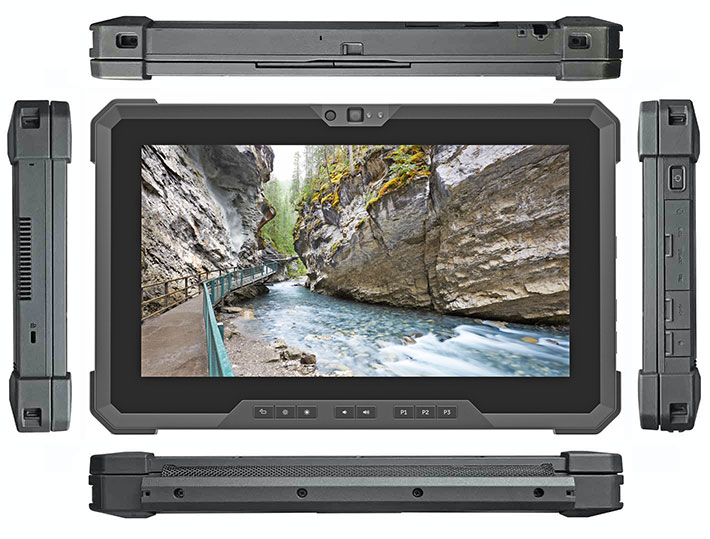
Below the display, which is clearly designed to be used in landscape orientation, are eight physical buttons. The layout now also includes brightness up/down buttons that were missing in earlier versions, a very valuable addition in a tablet. All labels are very legible. The front camera is in the center where it belongs, and it has a manual shutter.
Ports and connectivity are concentrated on the right side of the tablet. To guard against physical damage, all ports are located behind protective doors that snap into place. The picture below shows the right side of the unit with all protective doors removed for a better view at the ports.

From left to right: Power, protected by a single plug; a micro serial port also protected by a single plug; USB 3.0 Type C, USB 3.1 Type A, microSD card, and 3.5mm audio protected by a combined single plug. To the right of that is the small illuminated power button. This is different from earlier Dell Rugged Tablets that had ports on both the left and the right side.
Overall, the design of the Dell Latitude 7220 Rugged Extreme Tablet impresses on all fronts. While not insubstantial, this is an elegant, practical, functional solution that looks and feels just right.
Capacitive multi-touch — works with gloves
The Dell Latitude 7220 Rugged Extreme Tablet, like virtually every other modern tablet, offers 10-point capacitive multi-touch. Tapping, panning, swiping, pinching and zooming work smoothly and effortlessly with none of the slight delay that used to mar touch on Windows hardware.
The capacitive touch screen of the Rugged Tablet also handles gloves quite well. Tthe tablet display surface is as smooth as we've come to expect from capacitive touch technology.
 The tablet comes with a 4-1/4 inch capacitive stylus. Interestingly, Dell replaced the predecessor 7212 tablet's stylus that had a narrow 3mm hard rubber tip with a stylus that has a much harder 6mm tip. The new stylus does provide a pencil-like sensation and even sound, but we had to get used to a stylus withsuch a thick tip. When not in use, the stylus, which has an almost foot-long spiral tether cord, can be parked in a special garage on top of the tablet. The tablet comes with a 4-1/4 inch capacitive stylus. Interestingly, Dell replaced the predecessor 7212 tablet's stylus that had a narrow 3mm hard rubber tip with a stylus that has a much harder 6mm tip. The new stylus does provide a pencil-like sensation and even sound, but we had to get used to a stylus withsuch a thick tip. When not in use, the stylus, which has an almost foot-long spiral tether cord, can be parked in a special garage on top of the tablet.
In our use of the Dell Rugged Extreme Tablet (which extended over several month), we almost always took the detachable keyboard with us when on the road. It snaps on so easily and so securely that it's like having a laptop. Touch was precise enough for most tablet operations, though we also often used the stylus. On the desktop we often used the device as a laptop. Having a personal preference of mice over touchpads, we used a small generic bluetooth mouse with it.
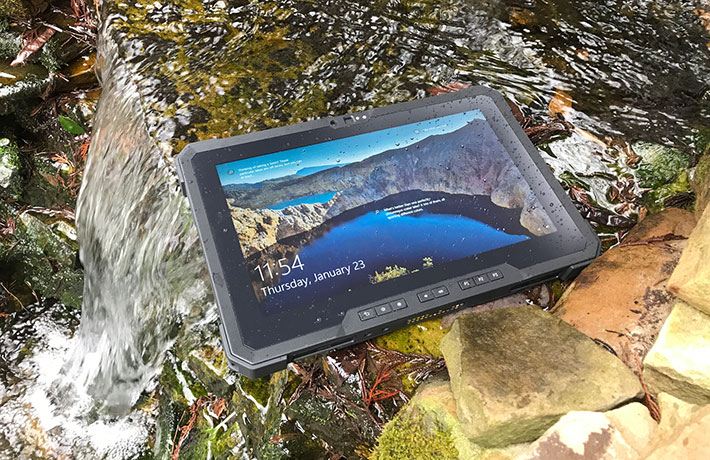
Performance: Cores galore
On the processor side of things, there's a very significant difference between the original Dell 12 Rugged Tablet and the current Dell Latitude 7220 Rugged Extreme Tablet version. With the initial model, customers had their choice of two CPUs from Intel's Core-M lineup. The latest model offers your choice of three far more powerful Intel "Whiskey Lake" 8th generation Core versions. Why does is this important?
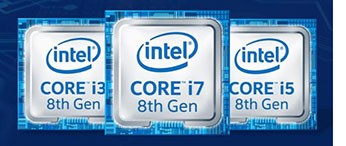 It is important because the original Core-M was specifically developed for fanless tablets where silent operation, a thin profile, and low weight mattered. These chips had to dissipate as little heat as possible, and that meant running them at a very low default clock speed. It is important because the original Core-M was specifically developed for fanless tablets where silent operation, a thin profile, and low weight mattered. These chips had to dissipate as little heat as possible, and that meant running them at a very low default clock speed.
The Core-M chips in the original tablets were rated at just 4.5 watt Thermal Design Power. They could run at much higher turbo speeds, but only for a brief time. This made them suitable for low overall workloads, with just a bit of high load mixed in.
It's an interesting idea, but in our experience, those Core-M chips were quite temperamental (as are, to a somewhat lesser extent, their successors) and you could never quite predict whether they would actually spool up to turbo speeds, or sit a particular assignment out. Not exactly what one needed out there in the field.
Dell apparently came to the same conclusion. Yes, tablets must be as thin and light as possible, but not at the expense of consistent, reliable performance. As a result, with the 2nd generation of the tablet, Dell switched from 4.5 watt Core-M processor to "full" ultra-low voltage Core processors with a Thermal Design Power of 15 watts. And now, with the 7220, all processors are powerful 8th generation Core chips.
But doesn't that mean much higher battery draw? Not necessarily. Intel has made significant progress in power conservation, and late generation mobile Core processors can have amazingly small power draws. The table below shows the three processors available for the Dell Latitude 7220 Rugged Extreme Tablet, with their major specs (see the full table here):
|
CPU Options
|
Intel
|
Intel
|
Intel
|
|
Intel
|
Core i7-8665U
|
Core i5-8365U
|
Core i3-8145U
|
|
Codename
|
Whiskey Lake
|
Whiskey Lake
|
Whiskey Lake
|
|
Cores/Threads
|
4/8
|
4/8
|
2/4
|
|
Lithography
|
14mn
|
14mn
|
14mn
|
|
Base Clock Speed
|
1.90 GHz
|
1.60 GHz
|
2.10 GHz
|
|
Turbo Speed
|
4.80 GHz
|
4.10 GHz
|
3.90 GHz
|
|
Thermal Design Power (TDP)
|
15 watts
|
15 watts
|
15 watts
|
|
Smart Cache
|
8MB
|
6MB
|
4MB
|
|
Integrated graphics
|
Intel UHD Graphics 620
|
Intel UHD Graphics 620
|
Intel UHD Graphics 620
|
|
Graphics base speed
|
300 MHz
|
300 MHz
|
300 MHz
|
|
Graphics max speed
|
1.15 GHz
|
1.10 GHz
|
1.00 GHz
|
|
Intel vPro
|
Yes
|
Yes
|
No
|
|
Intel SIPP
|
Yes
|
Yes
|
Unknown
|
|
Intel Trusted Execution
|
Yes
|
Yes
|
No
|
|
CPU relative cost
|
1.46
|
1.06
|
1.00
|
At the low end is the Core i3-8145U. This chip is the only dual-core model of the trio. That's not inherently bad; no ultra-low voltage Intel Core chip of the first seven generations ever had more than two cores. And the since it's a dual-core design, Intel allowed it — likely for power consumption reasons — a higher default clock speed than the quad-core options. As a result, the i3-8145U will probably handle light loads and routine jobs just as well as the two higher-end chips.
The Core i5-8365U and Core i7-8665U both have four cores and eight threads, with the i7 chip also having more Intel Smart Cache (8mb instead of 6mb) and slightly quicker maximum graphics. Other than that and overall slightly higher performance of the i7-8665U, there isn't much of a difference between the two.
Customers will likely ask themselves: Are four cores really twice as good as two? The answer is, as in almost all things, "it depends." It depends on how much of a software application can be broken down into steps that can be run in parallel. If it's a lot, then a quad-core design will likely be considerably faster than a dual-core CPU.
But doesn't that also mean considerably higher power draw? Again, that depends. If a quad-core design runs at the same default clock speed as a dual-core system with the same architecture, then, yes, it'd draw much more power. And that's why, for now, Intel lowered the default clock speed of the quad-core chips by quite a bit. And, thanks to optimization in the 8th generation dye, managed to increase maximum turbo speed.
The result is that, theoretically, the quad-core chips Dell offers for this tablet can match or exceed dual-core performance when just idling along doing light loads and drawing not much power. But they have much higher peak performance.
In order to get a sense of the Dell Latitude 7220 Rugged Extreme Tablet's performance, we installed Passmark Software's PerformanceTest 6.1 and 9.0 that run many dozens of tests covering CPU, 2D graphics, 3D graphics, memory, and disk and then compute scores for each category and an overall PassMark score. We also ran our older benchmark suite, CrystalMark, which concentrates on single core performance. For comparison, we added the results of Dell's original Latitude 12 Rugged Tablet, the second gen Latitude 12 Rugged Tablet Extreme, and three tablet competitors that we had also recently tested in the RuggedPCReview benchmark lab.
|
Dell Latitude 7220 Rugged Extreme Tablet Benchmarks and Comparisons
|
|
COMPARISON
|
Dell
|
Dell
|
Dell
|
DT Research
|
Getac
|
Winmate
|
|
Model
|
12 Rugged Tablet 7220
|
12 Rugged Tablet Extreme
|
12 Rugged Tablet
|
DT301X
|
UX10
|
M133WK
|
|
Type
|
Tablet/2-in-1
|
Tablet/2-in-1
|
Tablet/2-in-1
|
Tablet/2-in-1
|
Tablet/2-in-1
|
Tablet/2-in-1
|
|
Year tested
|
2020
|
2018
|
2017
|
2019
|
2020
|
2020
|
|
Display
|
11.6" 1920 x 1080
|
11.6" 1920 x 1080
|
11.6" 1366 x 768
|
10.1" 1920 x 1200
|
10.1" 1920 x 1200
|
13.3" 1920 x 1080
|
|
Processor Type: Intel
|
Core i7
|
Core i5
|
Core M
|
Core i7
|
Core i7
|
Core i5
|
|
Processor Model
|
8665U
|
7300U
|
5Y71
|
8550U
|
8265U
|
8265U
|
|
Cores/Threads
|
4/8
|
2/4
|
2/4
|
4/8
|
4/8
|
4/8
|
|
CPU Speed
|
1.90GHz
|
2.60GHz
|
1.20GHz
|
1.80GHz
|
1.60GHz
|
1.60GHz
|
|
Turbo Speed
|
4.80GHz
|
3.50GHz
|
2.90GHz
|
4.00GHz
|
3.90GHz
|
3.90GHz
|
|
Thermal Design Power (TDP)
|
15 watts
|
15 watts
|
15 watts
|
15 watts
|
15 watts
|
15 watts
|
|
BatteryMon minimal draw
|
2.8 watts
|
3.6 watts
|
3.3 watts
|
3.5 watts
|
2.4 watts
|
3.6 watts
|
|
CPU Mark 6.1
|
9,925.1
|
5,245.9
|
2,683.8
|
8,182.9
|
10,103.6
|
8,326.7
|
|
2D Graphics Mark 6.1
|
490.7
|
454.7
|
370.6
|
419.3
|
441.8
|
464.4
|
|
Memory Mark 6.1
|
2,404.1
|
1,628.1
|
1,948.5
|
1,338.3
|
1,881.8
|
2,369.0
|
|
Disk Mark 6.1
|
13,505.2
|
5,980.5
|
17,808.6
|
3,740.1
|
3,605.1
|
16,727.7
|
|
3D Graphics Mark 6.1
|
810.4
|
496.5
|
440.3
|
468.9
|
561.7
|
610.3
|
|
Overall PassMark 6.1
|
5,979.5
|
3,028.8
|
1,694.0
|
6,233.4
|
3,918.0
|
6,158.4
|
|
CPU Mark 9.0
|
9,301.4
|
5,394.0
|
NA
|
8,658.0
|
7,648.9
|
7,784.5
|
|
2D Graphics Mark 9.0
|
719.2
|
669.9
|
NA
|
625.9
|
613.0
|
657.2
|
|
Memory Mark 9.0
|
2,658.5
|
2,219.9
|
NA
|
2,379.6
|
2,195.4
|
2,400.7
|
|
Disk Mark 9.0
|
17,541.3
|
7,611.8
|
NA
|
23,816.7
|
4,038.0
|
28,141.2
|
|
3D Graphics Mark 9.0
|
1,295.3
|
1,133.9
|
NA
|
1,200.2
|
1,075.7
|
1,090.6
|
|
Overall PassMark 9.0
|
3,960.3
|
3,083.7
|
NA
|
3,601.9
|
3,089.0
|
3,511.0
|
|
ALU
|
80,073
|
55,826
|
32,389
|
71,046
|
77,607
|
73,559
|
|
FPU
|
50,881
|
51,538
|
26,550
|
58,384
|
57,488
|
54,520
|
|
MEM
|
88,050
|
50,206
|
29,070
|
73,714
|
49,827
|
57,451
|
|
HDD
|
70,396
|
56,857
|
38,565
|
71,929
|
40,985
|
90,405
|
|
GDI
|
21,844
|
18,294
|
11,673
|
20,667
|
17,048
|
18,905
|
|
D2D
|
6,833
|
6,338
|
4,373
|
5,211
|
5,613
|
6,606
|
|
OGL
|
14,106
|
13,792
|
6,843
|
10,596
|
12,417
|
10,865
|
|
Overall CrystalMark
|
332,183
|
252,851
|
149,463
|
311,547
|
260,985
|
312,311
|
As always, the results in the above table should not be construed as an absolute comparison of which product is fastest. Each of the listed devices comes/came with several processor options, and products may have been upgraded since we last benchmarked them in the RuggedPCReview.com testing lab. So view the numbers as what sort of performance can be expected from different types of processors and processor generations, clock speeds, and thermal design powers.
What is immediately clear is that this latest implementation of Dell's rugged tablet is vastly faster than the original tablet, and also very substantially faster than the second gen tablet we tested a couple of years ago. Compared to serious current-day rugged tablet competition, the Dell Latitude 7220 Rugged Extreme Tablet meets or beats them in most relevant benchmarks. It even beats the fastest rugged tablet we tested in 2019 in two out of three overall benchmark results. So we're talking serious performance here.
While most customers look at the chosen processor as the main determinant of system performance, the choice of mass storage type is equally, or even more, important. That's because PCIe NVMe-based storage is much faster than the older SATA variety. All Dell 7220 tablets now come with PCIe NVMe solid state disk, albeit not of the very fastest variety.
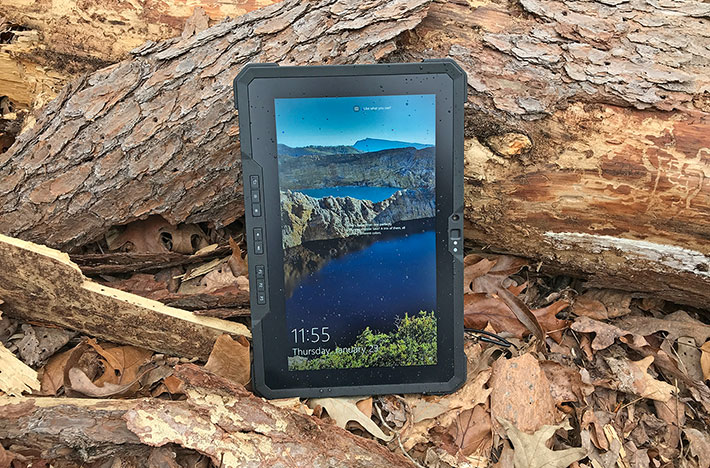
What it all means is that while Dell's initial rugged tablet wasn't a stellar performer, the latest Dell Latitude 7220 Rugged Extreme Tablet definitely is. High, sustainable performance is crucial in many field applications, and Intel's 8th generation Core chips definitely provide that. But four cores are better than two, and for that reason alone we'd recommend a four core version, with the i5-8365U probably offering the best cost/benefit.
Excellent performance and long battery life
The 10 hour-plus battery life of consumer tablets such as the iPad has spoiled customers who now expect full-shift battery life from their ruggedized Windows tablets as well. Microsoft Windows' steadily improving power conservation measures, Intel's impressive efforts in making their chips more power-efficient, better batteries, and tablet manufacturers' growing expertise combine to give modern Windows tablets more performance and longer battery life. Is the Latitude 12 Rugged Extreme Tablet one of them?
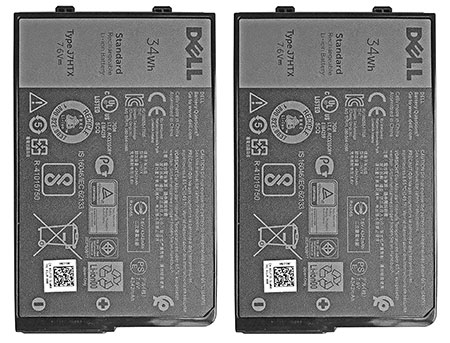 First a few words about the power situation of the Latitude 12 Rugged Extreme Tablet. The device has two battery bays, each accommodating either a 26 watt-hour or a 34 watt-hour Lithium-Ion battery. That's either a combined 52 or 68 watt-hours. First a few words about the power situation of the Latitude 12 Rugged Extreme Tablet. The device has two battery bays, each accommodating either a 26 watt-hour or a 34 watt-hour Lithium-Ion battery. That's either a combined 52 or 68 watt-hours.
The dual battery system means users can hot-swap one battery for a freshly-charged one at a time. Dell claims up to 19 hours of battery life from systems with two 34 watt-hour batteries. Could our review Dell Latitude 7220 Rugged Extreme, equipped with dual batteries, deliver? To find out we tested power draw with PassMark's BatMon utility.
|
Dell Latitude 7220 Rugged Extreme Power Draws (at idle)
|
|
Backlight level
|
Lowest (0%)
|
50%
|
Maximum (100%)
|
|
Power Saver
|
2.8 watts (24.3 hrs)
|
3.3 watts (20.7 hrs)
|
4.9 watts (13.9 hrs)
|
|
Max Performance
|
3.5 watts (19.4 hrs)
|
4.6 watts (14.8 hrs)
|
9.9 watts (6.9 hrs)
|
With the Windows power settings to "Power Saver" and screen brightness at its dimmest (which is very dim), we saw a power draw as low as 2.8 watts, good for a theoretical 24.3 hours. With the backlight at 50%, we saw 3.3 watts, good for a theoretical 20.7 hours. And with the backlight all the way up, power draw rose to a still very modest 4.9 watts, good for a theoretical 13.9 hours.
With the Windows power settings to "Max Performance" and screen brightness at its dimmest, we saw a power draw as low as 3.5 watts, good for a theoretical 19.4 hours. With the backlight at 50%, we saw 4.6 watts, good for a theoretical 14.8 hours. And with the backlight all the way up, power draw rose to 9.9 watts, bringing theoretical battery life down to 6.9 hours.
Overall, we found the Latitude 7220 Rugged Extreme Tablet to be amazingly power-efficient. The minimum observed draw of just 2.8 watts of our top-of-the-line 15-watt Core i7-8665U test machine was actually 0.8 watts lower than what we observed on a prior generation Dell Rugged Tablet with a lower-end 15 watt Core i5-7300 processor. So if push comes to shove and all power conservation modes and settings are activated, the Dell Latitude 7220 Rugged Extreme not only meets the 19 hours Dell claims, but can lasts over five hours longer than the spec.
That said, settings are crucial. Compared to the prior tablet we tested, the 7220 display has twice the nits, 1000 vs just 500. In the "best battery life" setting, maximum display brightness is considerably less than maximum brightness in "best performance" mode, hence the rather substantial impact on theoretical battery life (13.9 hours versus just 6.9 hours).
A look inside the Dell Latitude 7220 Rugged Extreme Tablet
If you open a premium consumer tablet (which is often next to impossible), you will find a huge battery and a tiny circuitboard inside, and very little else. That's because the electronics of consumer tablets are hyper-miniaturized and very much closed systems. A rugged Windows tablet is very different from that. In essence, it's a full PC squeezed inside a slender box. That means a good degree of miniaturization also, but almost everything still looks like PC components, with standard connectors, components and modules. And that's what you find inside of the Latitude 7220 Rugged Extreme Tablet.
Another challenge makers of rugged Windows tablets face is that they have to build this complex package with all those standard PC ports so that dust and water won't get inside. And they have to design the package so things don't break or come loose when the device is dropped and rattled around. How did Dell go about making it all possible?
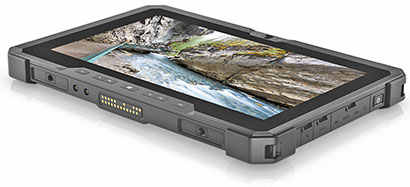 By expanding on existing technology. When Dell initially designed their rugged tablet platform, they had already launched their existing Latitude 12 Rugged Extreme convertible notebook (see our full review), and that machine serves as the conceptual and general foundation for Dell's rugged tablets. By expanding on existing technology. When Dell initially designed their rugged tablet platform, they had already launched their existing Latitude 12 Rugged Extreme convertible notebook (see our full review), and that machine serves as the conceptual and general foundation for Dell's rugged tablets.
In essence, Dell condensed the guts of their convertible into a pure tablet form factor, retaining the same 11.6-inch display size and much of the functionality. The pure tablet form factor enabled them to reduce weight by 40% compared to the convertible, and, of course, they updating underlying technologies in the process.
That's not to say that the tablet and the convertible used the same internal layout. Tablets and convertibles are inherently different, with convertibles being two-box designs and tablets all-in-ones.
Unlike most mobile Windows systems, the Latitude 7220 Rugged Extreme Tablet doesn't have any removable covers on its backside to provide access to RAM memory and internal expansion slots. So if you want to replace memory or one of the PCIe modules, or if maintenance becomes necessary, you have to open up the tablet.
That's fairly easy. Undo a couple of dozen small Philips screws and the halves come apart. There are, however, three ribbon cables with fragile connectors between the halves. These connectors have to be carefully unplugged.
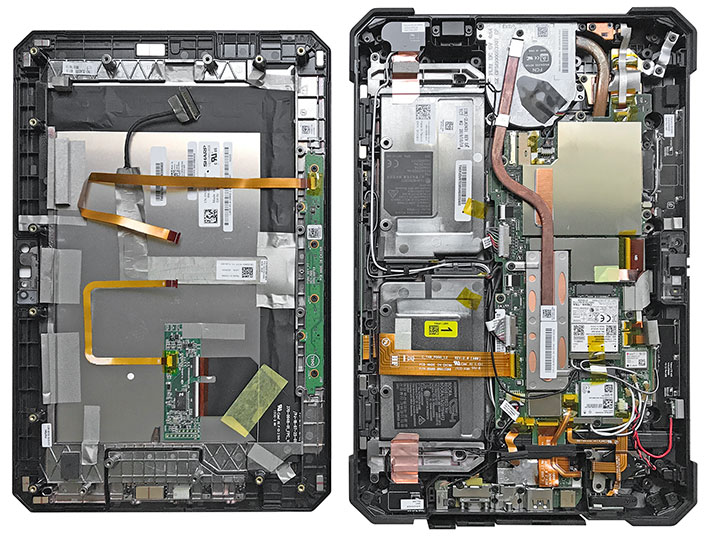
The seal between the back and the front part of the housing — both made of impact-resistant, flame-retardant, fiber-reinforced PC-GF50(40) polycarbonate — is a hard plastic lip on the backside that presses onto a thin black (in designs like that, we like to see the seal in a contrasting color; that makes it much easier to examine it for damage) rubber o-ring seal sitting in a channel on the front side. The o-ring seal is long and complex but seems replaceable. What's interesting here is that the seal doesn't just go along the perimeter of the tablet. Instead, it weaves in and out, protecting the electronics inside, but leaving anything I/O-related outside.
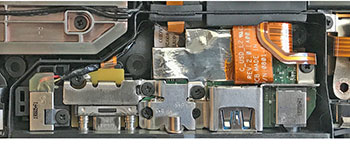 That's because it is not easy to properly seal standard PC ports and connectors. In most rugged devices those ports are not actually sealed to the inside. Instead, rubber plugs and hinged doors provide the protection. If one of them isn't closed properly, liquids can enter the inside of such devices. With Dell's design, it can't. That's because it is not easy to properly seal standard PC ports and connectors. In most rugged devices those ports are not actually sealed to the inside. Instead, rubber plugs and hinged doors provide the protection. If one of them isn't closed properly, liquids can enter the inside of such devices. With Dell's design, it can't.
In the Dell tablet there are protective plugs also, but if one of them is damaged or not closed properly, liquid may enter the I/O compartment they protect but it can't get into the interior of the tablet. Doing it this way is more complex, but potential damage is limited to an I/O module and not the entire tablet. And I say "potential" damage, because Dell actually applies what they call HZO liquid protection and describe as a "nanotechnology solution that inoculates electronic components from damage and failure."
An additional advantage of separating I/O modules from the motherboard is that this makes it much easier to upgrade and/or customize I/O. No need to redesign the motherboard.
Even though the internal layout of the Latitude 7220 Rugged Extreme Tablet is complex, components such as WiFi (ours had an Intel Model AX200NGW half-card), PCIe NVMe SSD mass storage, GPS (NEO-M8N), and other wireless modules, as well as the various antenna blocks, are easily accessible once the tablet has been opened.
The modularity, of course, is in Dell's DNA, the result of decades of offering an almost infinite number of permutations of options available right on Dell's website. So almost any feature for which there might be alternatives — or of which a customer might want more or less of — is not on the motherboard but designed as modules.
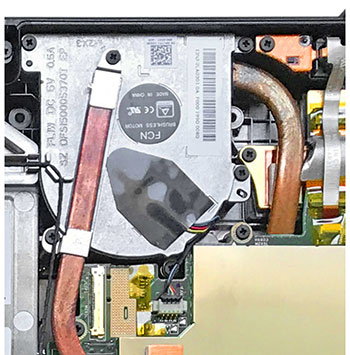 One thing that's immediately obvious is that the Latitude 7220 Rugged Extreme Tablet packs industrial-grade thermal management. That includes a fairly sizable fan with a heavy metal enclosure that, of course, is sealed towards the interior of the device. Two copper pipes conduct heat away from the processor, ancillary electronics, and also the PCIe-based SSD. One thing that's immediately obvious is that the Latitude 7220 Rugged Extreme Tablet packs industrial-grade thermal management. That includes a fairly sizable fan with a heavy metal enclosure that, of course, is sealed towards the interior of the device. Two copper pipes conduct heat away from the processor, ancillary electronics, and also the PCIe-based SSD.
Interestingly, the initial Dell Rugged Tablet only had a tiny and nearly invisible fan and no heat pipes. Why the change to beefier thermal management? That's because the original tablet's processor had a TDP rating of just 4.5 watt whereas the one in this tablet is a 15 watt design.
But 15 watts is still considered ultra-low voltage by Intel, and aren't all ultra-low voltage processors supposed to be able to operate without fans in Windows tablets?
Initially, yes, under certain circumstances. That's because early Intel ultra-low voltage processor did not have a "turbo" mode that allows CPUs to briefly run much quicker than their nominal clock frequency, as long as temperatures don't exceed certain levels.
Turbo mode is great, but it can turn into a problem in rugged machines. When a machine gets too hot out there in the desert and there is no active cooling, performance will drop, and can drop to unacceptable levels. That's why Dell chose to use a powerful fan in the Latitude 7220 Rugged Extreme Tablet. This way, performance will not drop, no matter what.
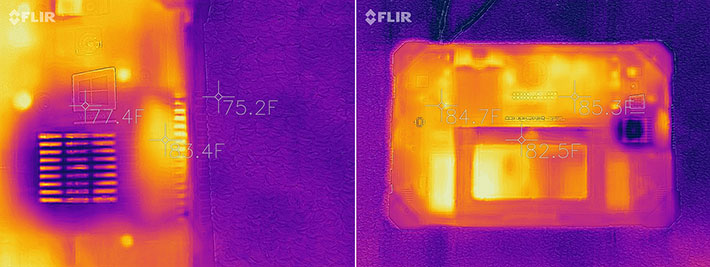
The pictures above show the Dell Rugged Extreme Tablet's thermal engineering, taken with our FLIR One Pro infrared camera during a performance test benchmark run.
The bright yellow areas are the hottest, and that is where the heat is conducted away from electronics via the system's copper pipes. On the left side of the picture you can see the fan and its cooling effect. As a result, even during a sustained high performance load we never saw more than mid 90F degree temperatures.
Overall, the interior of the Dell Latitude 7220 Rugged Extreme Tablet is a complex, sophisticated affair that very much shows Dell's experience in mobile computing technology. Components and modules are clearly marked and have their own 2D scan code. Wires that go from modules to their respective antennae located around the perimeter of the tablet for best reception are guided and held in place with little loops and guides.
Very good display
The Latitude 7220 Rugged Extreme Tablet has a display that measures 11.6 inches diagonally. It offers 1920 x 1080 pixel resolution, which makes for HD-standard 16:9 wide format aspect ratio and 190 ppi (pixels per inch). That's a nice step up from of the original Latitude 12 Rugged Tablet that came with lower 1366 x 768 pixel resolution and only 135 ppi. Even 190 ppi dpi is not terribly sharp by today's leading smartphone and tablet standards, but it looks nice and crisp and is also the same as what most of the direct competition offers.
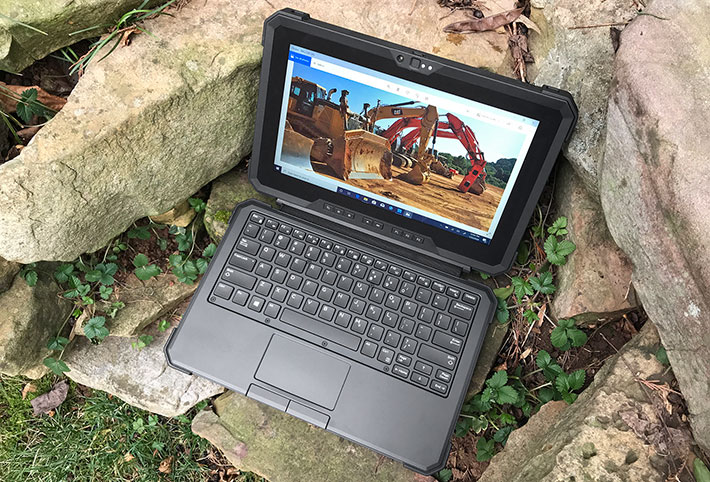
But, regardless of size or sharpness, providing the right display for a system that's being used outdoors is much more difficult than for one that's mostly used indoors in an office or at home. That's because we now have incredibly sharp, photorealistic-grade displays for indoor use, displays that one can't imagine getting much better. But outdoors is a totally different story.
That's because a) it's much brighter outdoors, with even the brightest display not being a match for sunlight, and b) because there are all sorts of reflections that can quickly make a display unreadable.
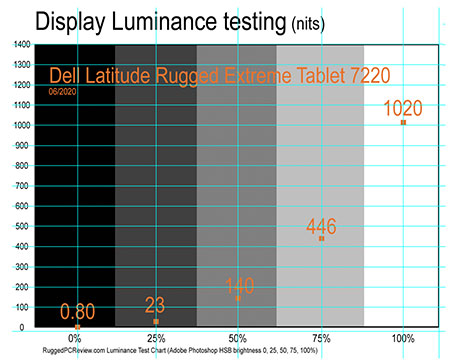 With regard to LCD outdoor viewability, Dell has been a pioneer. As far back as 2007, Dell had laptop displays that had their screen cover optically bonded to the LCD, thus eliminating the reflections from the LCD surface, eliminating the need to AR-coat the bottom of the screen cover, and eliminating the air gap. With regard to LCD outdoor viewability, Dell has been a pioneer. As far back as 2007, Dell had laptop displays that had their screen cover optically bonded to the LCD, thus eliminating the reflections from the LCD surface, eliminating the need to AR-coat the bottom of the screen cover, and eliminating the air gap.
The methods Dell applied reduced overall reflectivity and resulted in a very good effective contrast ratio. At the time, we termed it "definitely readable in sunlight." That was rare back then.
Time doesn't stand still though, and good outdoor-viewable displays are now available from all of the major rugged laptop vendors. Some are offering very high screen brightness of up to 1,500 nits, and optical treatments are continually refined. In the past, Dell favored advanced optical treatments that concentrated on reducing reflected light as opposed to using battery-draining super-bright backlights. That meant reducing the number of layers as each surface reflects sunlight back at the user, or bonding layers together to eliminate surfaces. And it also meant using anti-reflective (AR) and anti-glare (AG) coatings. These two measures combined made for impressive outdoor viewability even without a strong backlight (the Dell tablet we tested in 2017 offered 560 nits luminance).
560 nits made earlier Dell tablets nice and bright, but Dell apparently decided to amp up brightness anyway, and so the Latitude 7220 Rugged Extreme Tablet's display clocks in at an impressive 1,000 nits of luminance (RuggedPCReview measured 1,020 nits). For illustration, the pictures below are a side-by-side comparison between the 11.6-inch Dell screen and that of a 2nd gen Apple iPad Pro 12.9 we're using around the office for this and that.
In the first comparison image, both screens can easily be viewed outdoors, with the Dell tablet somewhat brighter than the iPad Pro 12.9, which is said to run at about 600 nits.

In the second comparison image, the tablets lay flat on the ground, facing the sky. Even in bright daylight both remain very readable, with the Dell again somewhat brighter. In the leftside picture, note the reflections on the glossy iPad display, whereas the semi-matte Dell display shows none.

The final picture below shows the Latitude 7220 Rugged Extreme Tablet outdoors, held so that it faces the sky. Note the total absence of reflections on the left side. That's a big plus of a semi-matte display. There is, however, always a tradeoff with current technology displays: on the right side you can see how the semi-matte display diffuses light instead of reflecting it back, as a glossy display would.
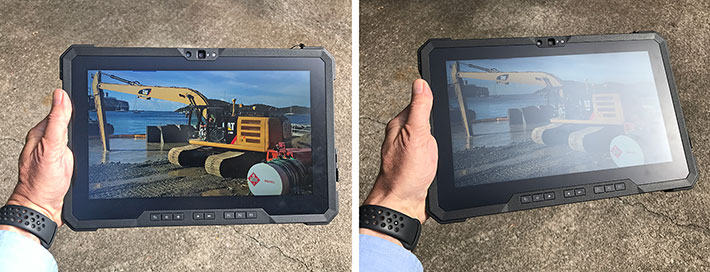
Hardware controls and the Dell Rugged Control Center
Tablets live and die by not only the ease at which they can be used and controlled, but also by tablet-optimized software, apps and utilities. That's especially important in the Windows world which, after all, is deeply rooted in decades' worth of the desktop/keyboard/mouse paradigm.
Dell knows that and that's the reason why their tablet has those physical control buttons to quickly adjust volume and screen brightness, toggle between portrait and landscape mode, and perform frequently used tasks with three programmable function keys.

While the buttons help augment the tablet experience on the hardware side, Dell's also addressing matters on the software side. That's where the "Rugged Control Center" app comes in. It includes a dashboard that can be populated with one-touch hardware controls and quick launch shortcuts, and also allows setting of the programmable hardware buttons (each has a short press and a long press function). There are also tabs for GPS status, overall system information, and settings.
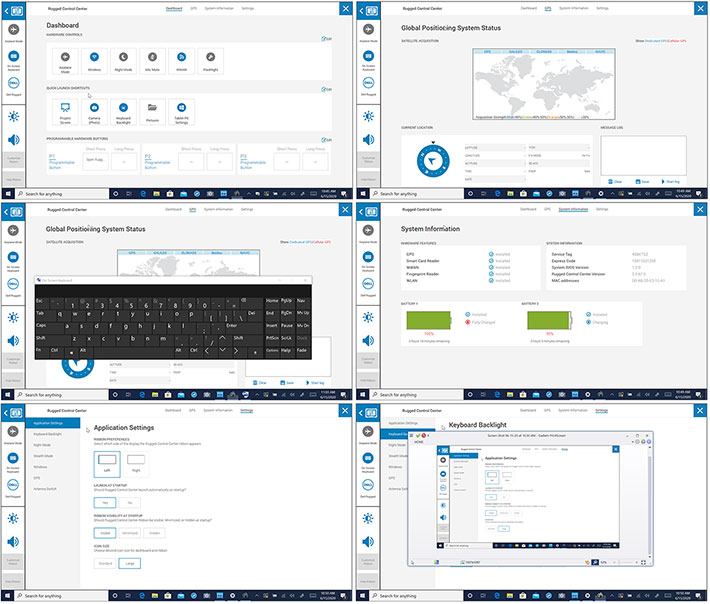
Cameras: good enough for many jobs
The Latitude 7220 Rugged Extreme Tablet can be ordered with an optional integrated 5MP video front webcam with a hand-operated privacy shutter, and also an 8MP rear camera with LED flash that also has a manual privacy shutter. Our eval unit had both, and the sample picture compilation was taken with the tablet's rear camera. Tap on the image collection to bring up a full size version in a separate window.

As is, the privacy shutters are clever low-tech solutions to guard against unauthorized snooping. 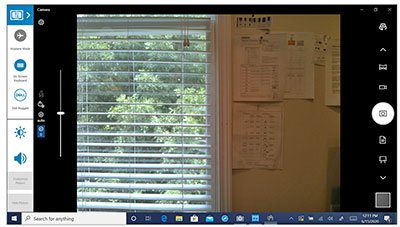 You simply slide the camera window over so the lens is covered.
You simply slide the camera window over so the lens is covered.
We used the default Windows 10 Camera app for the test pictures above. For image resolution, the documentation camera offers 11 settings, ranging from tiny 160 x 120 pixel pictures all the way up to 3264 x 2448 pixel (8megapixel). Video can be shot in ten formats, ranging from 120p up to 1080p, all at 30 frames per second. So no 4K video or slow motion. That's a bit disappointing in this day and age of stellar and incredibly competent smartphone cameras.
That said, both still pictures and video were of decent quality. The camera is fairly quick with stills, and video never fell behind. In addition to standard photo and video modes, the Camera app offers whiteboard, document, and panorama shooting modes. The app offers a "pro" mode that still only has very limited manual control that's limited to brightness, manual focus, time delay and flash.
Users who want more control and more settings will have to resort to third party camera apps.
Bottomline here is that today's users are spoiled by the excellent cameras built into smartphones and also by the sophisticated camera imaging apps that are available. The Dell tablet's cameras are not at that level and the Windows Camera app is marginal. The camera are, however, good enough for many documentation tasks, and certainly good enough for decent quality conferencing (which, of course, has become much more important as of late).
Tough enough for the field
Ruggedness and durability are sore subjects with consumer tablets where almost universally style prevails over substance. Largely because of that, Dell points out that the 5-year total cost of ownership of a rugged solution is actually only half that of a consumer product.
 When Dell initially announced the Latitude 12 Rugged Tablet in 2015, Dell product manager Umang Patel said that while there were lots of options in the rugged tablet space, fully rugged tablets are heavy and expensive, and in the lower price range there wasn't much that offered the kind of features and performance that many prospective tablet users need. So Dell aimed between those two extremes. When Dell initially announced the Latitude 12 Rugged Tablet in 2015, Dell product manager Umang Patel said that while there were lots of options in the rugged tablet space, fully rugged tablets are heavy and expensive, and in the lower price range there wasn't much that offered the kind of features and performance that many prospective tablet users need. So Dell aimed between those two extremes.
As a result, while the Dell Rugged Tablet, the Dell Rugged Extreme Tablet, and now the Latitude 7220 Rugged Extreme Tablet definitely look and feel solid and trust-inspiring, neither is a tank. Dell simply and logically designed its tablets to handle whatever conditions and eventualities would likely be encountered in the real world.
Dell considered being able to use their tablets in a wide range of temperatures, and so the Latitude 7220 Rugged Extreme Tablet can operate within an extremely wide temperature range of -20° to 145° Fahrenheit (-29° to 63°Centigrade), which means practically anywhere. It certainly didn't mind being used outdoors on several Winter outings in the Great Smokey Mountains in Tennessee.
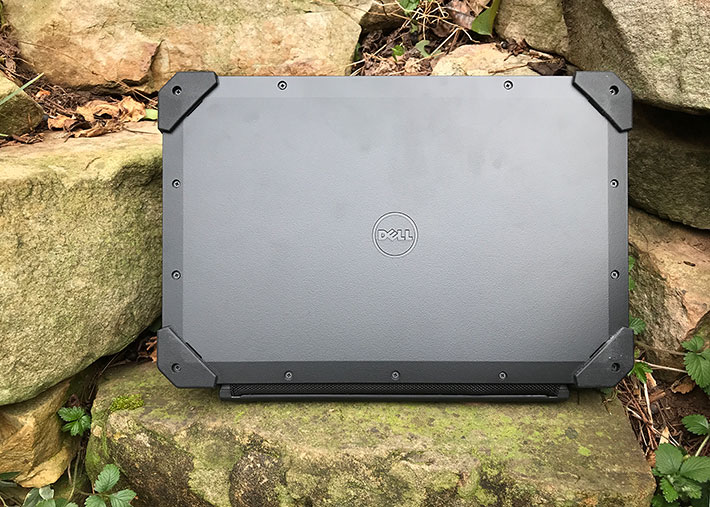
As for resistance to dust and liquids, the tablet carries an IP65 rating, where the "6" means the device is totally dust-proof, and the "5" that it can also handle low pressure water jets from all directions, albeit with "limited ingress permitted." Using the tablet in the rain is okay, spilling liquids on it is okay, but guard against submersion.
The images below were taken during a Dell media event late 2016 at Lake Travis outside of Austin, Texas. Original model Dell Rugged Tablets with CartoPac GPS-based course tracking software were strapped onto jet skis and taken on some speedy, bumpy rides. No problem. As you can see, the original 560 nits wasn't quite as bright as we'd have liked; the new Latitude 7220 Rugged Extreme Tablet fixes that with its much brighter display.
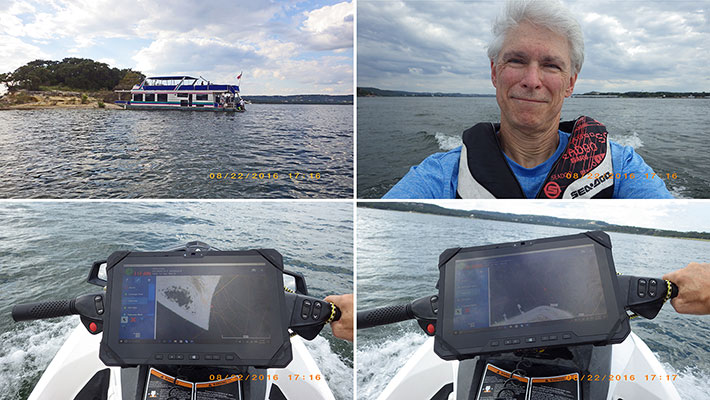
Drop tests were conducted in accordance with MIL-STD-810G, Method 516.6, Procedure IV procedures. Closed and not operating, the unit survived 26 drops from 48 inches. The maximum height tested while operating was 36 inches. That's also impressive, but we like to see the ability to survive 4-foot drops while open and operating, because that is the height at which a laptop might be held while in a standing position.
Dell says the device is also independently tested according to MIL-STD-810G and the newer MIL-STD-810H procedures for transit drop, blowing rain, blowing dust and sand, vibration, functional shock, freeze/thaw cycles, and more.
Dell generally has ruggedness testing done by SGS United States and SGD Taiwan, SGS being one of the world's leading inspection, verification, testing and certification companies. Additional testing was done by the Taiwan and China locations of UL, a global independent safety science company. The images below were taken at a tour of Dell's own ruggedness testing facilities in Austin, Texas.
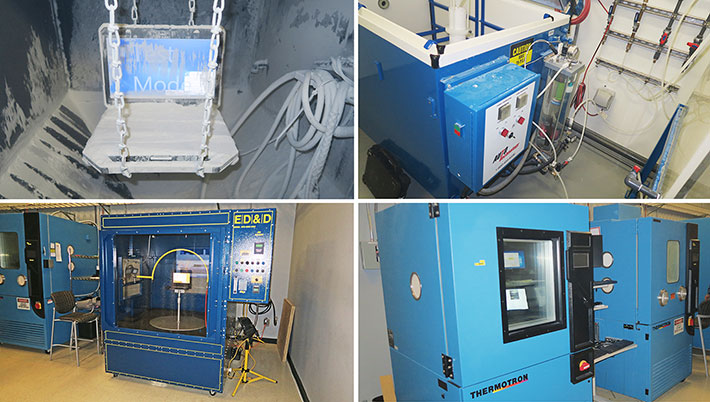
For use in hazardous locations, C1D2 certification is available. These are becoming more and more important, and they are a prerequisite for deployment in industries such as oil, gas, and petrochemical manufacturing, and many others where ignitable gases or vapor may be present.
Overall, the Latitude 7220 Rugged Extreme Tablet is just that, rugged. It's very well built, very sturdy, rubber bumpers provide good protection, and ports are well sealed with both plugs and sealing inside. That said, the emphasis here is on an intelligent balance of toughness and ease-of-use, not on heavy, vault-like invulnerability.
Summary: The Dell Latitude 7220 Rugged Extreme Tablet
The Dell Latitude 7220 Rugged Extreme Tablet is for those who a) want an exceptionally well designed and executed tablet for tough jobs, b) want a pure tablet, but one with a perfectly matched optional detachable keyboard, and c) prefer one-stop shopping with a world-leading provider of commercial PCs with large scale production experience and extensive support.
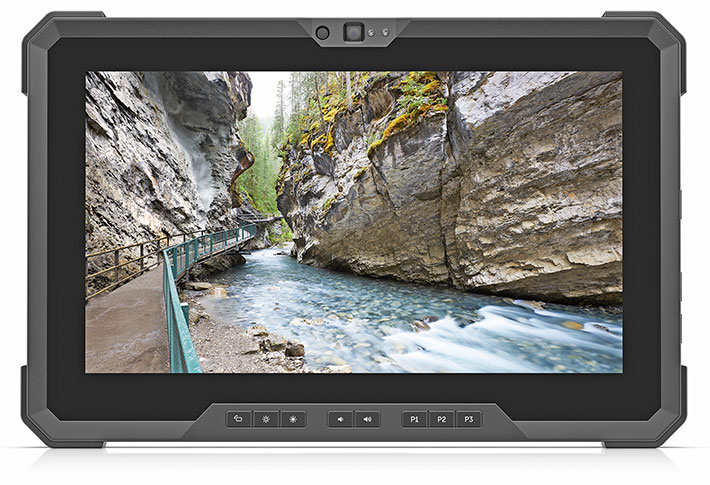
Its 11.6-inch 1920 x 1080 pixel display is bright and offers superior reflection control, making it easy to use outdoors and even in bright sunlight. It also provides effortless multi-touch capability that works even with gloves on. The included narrow-tip capacitive stylus works well, and there is also an active pen option. With a weight as low as 2.9 pounds, the tablet is remarkably light and handy for a device this rugged.
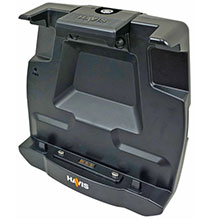 The Dell Rugged Extreme Tablet covers connectivity basics (USB, Micro HDMI, Micro SD card, Micro serial, audio) and can also be configured with fingerprint and standard or contactless smart card readers. Additional connectivity as well as barcode and magnetic stripe reading is available via bolt-on modules. For on-the-road use, there's a Havis vehicle dock with additional connectivity, for the office a handy desk dock with dual battery charging.
The Dell Rugged Extreme Tablet covers connectivity basics (USB, Micro HDMI, Micro SD card, Micro serial, audio) and can also be configured with fingerprint and standard or contactless smart card readers. Additional connectivity as well as barcode and magnetic stripe reading is available via bolt-on modules. For on-the-road use, there's a Havis vehicle dock with additional connectivity, for the office a handy desk dock with dual battery charging.
Available with a choice of three Intel 8th generation Core processors, the Dell Latitude 7220 Rugged Extreme Tablet combines excellent performance with very good power management, making double shift operation without battery recharging possible (we highly recommend, however, to get the optional second battery). Helping to achieve this high performance is very fast PCIe NVMe solid state primary storage, which has now replaced SATA as the standard in this tablet.
As the name implies, this is a rugged device designed to hold up to harsh conditions in the field. All ports have protective doors, there are protective bumpers, the construction is very solid, and Dell provides comprehensive ruggedness testing data.
Overall, in our long-term testing, the Dell Latitude 7220 Rugged Extreme Tablet never let us down and convinced us as an elegant, very competent tablet solution with enough performance and connectivity, very good expandability, and an excellent optional detachable keyboard that we highly recommend. – Conrad H. Blickenstorfer, June 2020
|
Dell Latitude 7220 Rugged Extreme Tablet Specifications
|
| Added/changed |
Full long-term review 05/2020
|
| Type
|
Rugged tablet
|
| CPU
|
Intel Core i7-8665U: 1.90GHz/4.80GHz, 4 cores/8 threads
Intel Core i5-8365U: 1.60GHz/4.10GHz, 4 cores/8 threads
Intel Core i3-8145U: 2.10GHz/3.90GHz, 2 cores/4 threads
|
| Thermal Design Power
|
All 15 watts
|
| OS
|
Windows 10 Pro
|
| Graphics
|
Intel UHD Graphics
|
| Memory
|
8GB or 16GB 2133MHz LPDDR3 Memory
|
| Display
|
"Direct-View" outdoor-readable, LED backlight, Gorilla Glass 3 protective front glass, 1020 nits as tested
|
| Display size and resolution
|
11.6-inch/1920 x 1080 pixel (190 ppi) 16:9
|
| Digitizer/Pens
|
Capacitive multi-touch, glove-capable; optional active pen
|
| Keyboard
|
Onscreen, optional external
|
| Storage
|
128GB, 256GB, 512GB, 1TB, or 2TB PCIe NVMe Solid State Drive
|
| Multimedia Pocket
|
None
|
| Slots
|
1 x microSD card
|
| Housing
|
Impact-resistant, flame-retardant, fiber-reinforced PC-GF50(40) polycarbonate
|
| Temperature
|
-20° to 145°F (-29° to 63°C)
|
| Humidity
|
MIL-STD-810G, Method 507.5, Procedure II, 10-90% noncondensing
|
| Vehicle vibration
|
ASTM D4169-04 (99), Schedule E, Truck Assurance Level II
|
| Salt Fog
|
MIL-STD-810G, Method 509.5, Procedure I (optional)
|
| Enclosure Class
|
IP65
|
| Altitude
|
MIL-STD-810G, Method 500.5, Procedure II (15,000 feet operating)
|
| Shock: Transit Drop
|
MIL-STD-810G transit drop (72/60/48"); 3-foot operating drop
|
| HazLoc
|
Optional: ANSI/ISA.12.12.01 certification capable (Class I, Division 2, Groups A, B, C, D)
|
| Certifications
|
See test report here (PDF).
|
| Size (inches)
|
12.3 x 8.0 x 0.96 inches (312 x 203 x 24 mm)
|
| Weight
|
Starting at 2.9 lbs. (1.3 kg) with single 2-cell battery
|
| Power
|
2-cell 34Wh Li-Ion, optional second 2-cell 34Wh Li-Ion
|
| Cameras
|
Optional: 5MP video front webcam with privacy shutter, 8mp rear camera with privacy shutter and LED flash
|
| Scanning
|
Optional: Dell Scanner Module
|
| Security
|
Optional: Fingerprint reader, Contactless Smart Card reader
|
| Sensors
|
Accelerometer, ambient light, digital compass, gyro, lid, SAR
|
| Communication
|
Intel Wireless-AC 9560 802.11ac with Bluetooth 5.0 OR Intel Wi-Fi 6 AX200 802.11ax with Bluetooth 5.0 OR Intel Wi-Fi 6 AX200 802.11ax w/o Bluetooth, opt. dedicated u-blox NEO-M8 GPS
|
| Interface
|
1 x USB 3.1 Type-A, 1 x USB 3.0 Type-C with DisplayPort/PowerShare, audio in/out, pogo-pin dock/kbd; optional: pogo-pin modular expansion (back) and mini RS232
|
| Price
|
Starting at US$1,899 (Dell website, June 2020)
|
| Website
|
Dell Latitude Rugged web page
|
| Ruggedness results
|
 Dell Latitude 7220 Rugged Extreme Tablet environmental testing report Dell Latitude 7220 Rugged Extreme Tablet environmental testing report
|
| Spec sheet
|
 Dell Latitude 7220 Rugged Extreme Tablet spec sheet Dell Latitude 7220 Rugged Extreme Tablet spec sheet
|
| Warranty
|
Standard 3-year next business day on-site service after remote diagnosis. Optional 3-year premium support with 24x7 global availability.
|
| |
